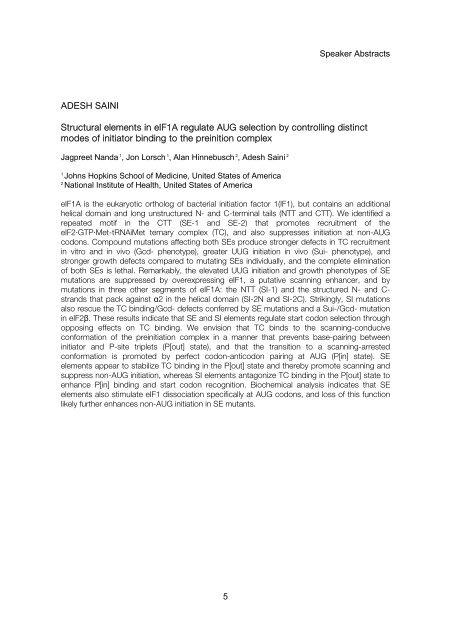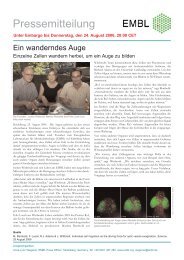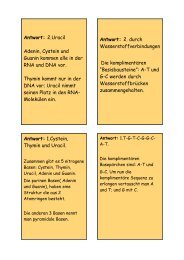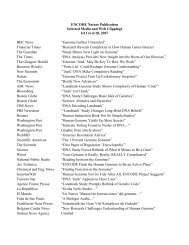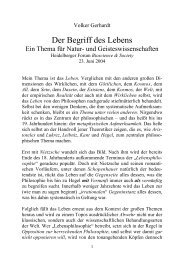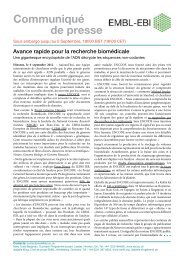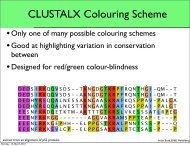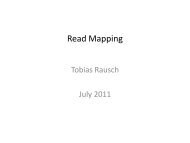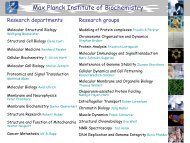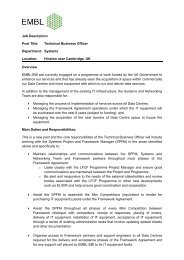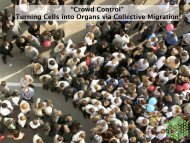EMBO Conference on Protein Synthesis and Translational Control
EMBO Conference on Protein Synthesis and Translational Control
EMBO Conference on Protein Synthesis and Translational Control
You also want an ePaper? Increase the reach of your titles
YUMPU automatically turns print PDFs into web optimized ePapers that Google loves.
ADESH SAINI<br />
5<br />
Speaker Abstracts<br />
Structural elements in eIF1A regulate AUG selecti<strong>on</strong> by c<strong>on</strong>trolling distinct<br />
modes of initiator binding to the preiniti<strong>on</strong> complex<br />
Jagpreet N<strong>and</strong>a 1, J<strong>on</strong> Lorsch 1, Alan Hinnebusch 2, Adesh Saini 2<br />
1 Johns Hopkins School of Medicine, United States of America<br />
2 Nati<strong>on</strong>al Institute of Health, United States of America<br />
eIF1A is the eukaryotic ortholog of bacterial initiati<strong>on</strong> factor 1(IF1), but c<strong>on</strong>tains an additi<strong>on</strong>al<br />
helical domain <strong>and</strong> l<strong>on</strong>g unstructured N- <strong>and</strong> C-terminal tails (NTT <strong>and</strong> CTT). We identified a<br />
repeated motif in the CTT (SE-1 <strong>and</strong> SE-2) that promotes recruitment of the<br />
eIF2·GTP·Met-tRNAiMet ternary complex (TC), <strong>and</strong> also suppresses initiati<strong>on</strong> at n<strong>on</strong>-AUG<br />
cod<strong>on</strong>s. Compound mutati<strong>on</strong>s affecting both SEs produce str<strong>on</strong>ger defects in TC recruitment<br />
in vitro <strong>and</strong> in vivo (Gcd- phenotype), greater UUG initiati<strong>on</strong> in vivo (Sui- phenotype), <strong>and</strong><br />
str<strong>on</strong>ger growth defects compared to mutating SEs individually, <strong>and</strong> the complete eliminati<strong>on</strong><br />
of both SEs is lethal. Remarkably, the elevated UUG initiati<strong>on</strong> <strong>and</strong> growth phenotypes of SE<br />
mutati<strong>on</strong>s are suppressed by overexpressing eIF1, a putative scanning enhancer, <strong>and</strong> by<br />
mutati<strong>on</strong>s in three other segments of eIF1A: the NTT (SI-1) <strong>and</strong> the structured N- <strong>and</strong> C-<br />
str<strong>and</strong>s that pack against α2 in the helical domain (SI-2N <strong>and</strong> SI-2C). Strikingly, SI mutati<strong>on</strong>s<br />
also rescue the TC binding/Gcd- defects c<strong>on</strong>ferred by SE mutati<strong>on</strong>s <strong>and</strong> a Sui-/Gcd- mutati<strong>on</strong><br />
in eIF2β. These results indicate that SE <strong>and</strong> SI elements regulate start cod<strong>on</strong> selecti<strong>on</strong> through<br />
opposing effects <strong>on</strong> TC binding. We envisi<strong>on</strong> that TC binds to the scanning-c<strong>on</strong>ducive<br />
c<strong>on</strong>formati<strong>on</strong> of the preinitiati<strong>on</strong> complex in a manner that prevents base-pairing between<br />
initiator <strong>and</strong> P-site triplets (P[out] state), <strong>and</strong> that the transiti<strong>on</strong> to a scanning-arrested<br />
c<strong>on</strong>formati<strong>on</strong> is promoted by perfect cod<strong>on</strong>-anticod<strong>on</strong> pairing at AUG (P[in] state). SE<br />
elements appear to stabilize TC binding in the P[out] state <strong>and</strong> thereby promote scanning <strong>and</strong><br />
suppress n<strong>on</strong>-AUG initiati<strong>on</strong>, whereas SI elements antag<strong>on</strong>ize TC binding in the P[out] state to<br />
enhance P[in] binding <strong>and</strong> start cod<strong>on</strong> recogniti<strong>on</strong>. Biochemical analysis indicates that SE<br />
elements also stimulate eIF1 dissociati<strong>on</strong> specifically at AUG cod<strong>on</strong>s, <strong>and</strong> loss of this functi<strong>on</strong><br />
likely further enhances n<strong>on</strong>-AUG initiati<strong>on</strong> in SE mutants.


